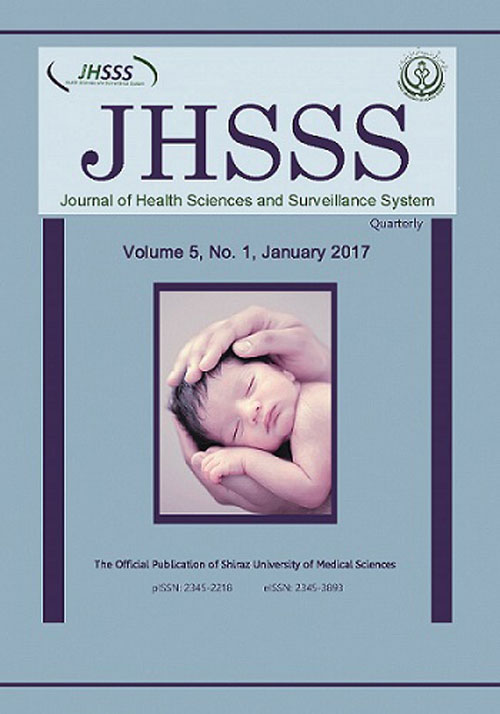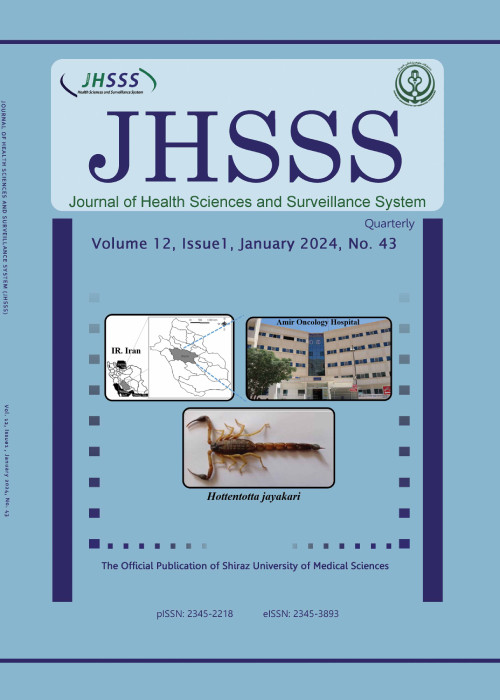فهرست مطالب

Journal of Health Sciences and Surveillance System
Volume:5 Issue: 1, Jan 2017
- تاریخ انتشار: 1395/12/22
- تعداد عناوین: 6
-
-
Pages 2-6Background/ObjectiveThis study was conducted to assess the prevalence of low birth weight and its risk factors in Fars province, south of Iran, 2014.MethodsIn this cross-sectional study, we collected data of 3,600 neonates through multi-stage random sampling. At first, we divided the hospitals into two strata, private and public. Then by stratified random sampling, we selected the neonates from delivery list in each hospital. In univariate analysis, the variables in which the p-value was less than 0.2 were entered into multivariate logistic regression analysis model for adjusting. Two-sided p valuesResultThe prevalence of low birth weight in Fars province was 8.7% (95% CI: 7.8% - 9.7%). In term birth, factors such as mothers age > 35 years, multiple birth and durationConclusionThe prevalence of low birth weight in Fars province was low in comparison to that of the world and other districts of Iran. But we should plan for reduction of low birth weight to achieve world health organizations goal. Variables of pregnancy interval of less than 2 years, multiple births, mothers age over 35 years and fathers level of education could predict low birth weight of the neonates.Keywords: Low birth weight, Prevalence, Risk factors, Iran
-
Pages 7-14BackgroundFungi are one of the pollutant emissions from the composting plants which change in variety during the composting process. They are predominant in stabilization stage.MethodsThis study assessed the thermotolerant airborne fungi based on NIOSH 0800 on 200 ambient samples from four composting processes and outdoor spaces in a composting plant.ResultsThe concentration of fungi during shredding, separatingand screening washigher than 1000 CFU/m3. The level of fungi in all stages was higher than outdoor(pConclusionThe results of this study showed that the concentration of airborne fungi was decreased during composting process. The effect of these aerosols on indoor air was more than that in the outdoor space and workers at this sitewere exposed to high levels of thermotolerantfungi.Therefore,air-condition, ventilation system and safety operations such as respiratory masks are essential. The results of this studycan be used inrisk assessment.Keywords: fungi, compost, Iran, Aspergillus, bioaerosol
-
Pages 15-21IntroductionOne of the aims of the family physician program (FPP) is to improve the maternal and child health indicators. this study aimed to comparison maternal and child health indicators in Shiraz rural areas before and after implementation of FPP during 2001 to 2012.MethodsThis applicable study was conducted in Shiraz in the south west of Iran in 2014. The child and maternal health indicators before (2001 to 2005) and after FPP (from 2006 to 2012) were gathered from the Health Center (Enghelab and Shohadaye Valfajr). The instrument for data collection was a questionnaire consisted of 20 maternal and child health indicators. Descriptive statistics was used and for analyzing the data, Excel and Stata software and comparisons of rates and joint point regression tests were employed.Resultsthe results showed that The FPP lead to decrease in stillbirth, infant mortality and child under one-year mortality in the rural area. Also all the vital horoscope indicator (mortality under one month, mortality under one year, the frequency of the infants under one year, the percentage of stillbirths, crude death percentage, crude birth percentage, general fertility percentage, total fertility percentage) have improved after FPP in Health Center rather than Enghelab Health Center .Conclusionthe maternal and child health indicators had improvement after FPP implementation. Therefore, it is recommended to continue the program.Keywords: Maternal, child health indicators, Rural health, Family physician
-
Pages 22-31Background and goal: The interaction between university and industry, due to its highly constructive and positive effects on technical, economic and social changes, was traditionally at the center of policy makers and planners attention. The aim of the present study was to explain barriers and challenges existing in the interaction between medical sciences universities and industry.MethodThis present descriptive-correlational study used measuring method fto investigate the interaction among Medical Sciences University (School of Public Health). 1468 individuals participated in this study. Using Morgan scale, 321 people were selected as the sample. Two questionnaires were prepared by the researcher. The proper governance questionnaire contains political, economic, social, legal and cultural dimensions composed of 69 questions. The barriers between university and industry questionnaire covering 3 dimensions of individual interaction barriers, organizational interaction barriers and environmental interaction barriers is composed of 40 questions. Data analysis was done using SPSS, version 21.ResultsBased on factor analysis of the data, the main dimension of proper governance respectively was cultural factors and among various factors of barriers between university and industry, environmental interaction dimension was considered as the most important one. Moreover, the results showed that there was a direct and meaningful relationship between dimensions of proper governance and interaction between university and industry variable.ConclusionBased on the results of the present study, considering culture and cultural differences can help improve the interaction between university and industry.Keywords: Medical Sciences University, interaction, industry, governance
-
Pages 32-37BackgroundThe close relationship between diet and disease emphasizes the need for optimal diet evaluation. The aim of this study was to compare the efficiency by which each of Healthy Eating Index (HEI)-2010, Diet Quality Index-International (DQI), Mediterranean Diet Score (MDS), and Diet Diversity Score (DDS) evaluates the diet.MethodsIn a cross-sectional design, 438 adults aged 20-50 years were recruited. Dietary intakes were assessed using a semi-quantitative food frequency questionnaire. HEI-2010, DQI, MDS, and DDS were calculated and scored according to their corresponding criteria.ResultsEnergy (1917 ± 554 kcal to 2898 ± 933 kcal), saturated fats (17.0 ± 6.8 g to 28.1 ± 11.5 g), and cholesterol (244 ± 195 g to 414 ± 343 g) increased across tertiles of DDS and energy (2017 ± 699 kcal to 2621 ± 748 kcal) increased across tertiles of DQI. In contrast, saturated fats decreased (23.9 ± 12.0 g to 20.8 ± 8.1 g for HEI-2010 and 23.7 ± 10.0 g to 20.5 ± 10.4 g for MDS), but energy and cholesterol did not change significantly across tertiles of HEI-2010 and MDS. Other nutrients either did not change or changed appropriately across tertiles of the different indices.ConclusionDDS and, to a less extent, DQI may not be good indicators of healthy diet especially in terms of obesity and cardiovascular diseases.Keywords: Healthy Eating Index, Diet Quality Index, Diet Diversity Score, Mediterranean diet
-
Pages 38-42ObjectivesThis study aimed to investigate the extent of implementation of safety measures in 14 student housings in one of the largest universities in Fars province, Shiraz, Iran.MethodA cross-sectional study was conducted in 14 student housings of one of the largest universities, located in Shiraz, Iran. Audit checklists were completed and rated thought field inspection and interview. Safety Requirement Index (SRI) was then used to evaluate the safety of student housings. SRI was graded on five scales (0-19%: very poor (unsafe); 20-39%: poor (relatively unsafe); 40-59%: moderate; 60-79%: good (relatively safe): and 80-100%: excellent (safe).ResultsThe mean SRI score was 71.01±15.46%. The highest and lowest level of SRI was 94.11±6.60% for dimensions of public health (and 47.70±18.42% for elevator safety.ConclusionNone of the studied housings was completely safe in all dimensions. Most of the studied housings were categorized as safe in the dimensions of public health and ventilation and air-conditioning systems; relatively safe in the dimensions of electrical, building, fire and kitchen safety; and moderate in the elevator safety and emergency response. Establishment of safety management system is necessary to promote safety in the studied housings. The results of this study indicated the need to inform the authorities about the safety priorities in housings, to promote the safety conditions. The results could also be used to raise awareness regarding their role and responsibilities about the safety of housings.Keywords: Housing, University, Safety


